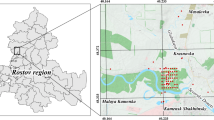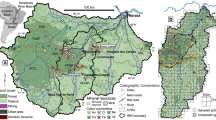Abstract
Geochemical association plots are used as a screening tool for environmental site assessments and use empirical log–log relationships between total trace metal concentrations and concentrations of a major (i.e., reference) soil metal constituent, such as iron (Fe), to discern sites with naturally elevated trace metal levels from sites with anthropogenic contamination. Log–log relationships have been consistently observed between trace metal and reference metal concentrations and are often considered constant. Consequently, we used a regional geochemistry data set to evaluate background trace metal/Fe log–log associations across soils with highly diverse composition. Our results indicate that, although geochemical associations may be proportional, they significantly differ across predominant United States Department of Agriculture (USDA) soil orders. This suggests that highly complex interactions between soil-forming factors and variable secondary clay mineral composition affect the ratio of trace metals to Fe concentrations in soils. Also, intra-order variability in trace metal/Fe ratios generally ranged multiple orders of magnitude which suggest that the order level of the USDA soil taxonomic system is insufficient to reasonably classify background trace metal concentrations. Consequently, geochemical association plots are a useful screening tool for environmental site assessments, but ubiquitous application of generic background metal data sets could result in erroneous conclusions. Because significantly different ratios were observed across predominant USDA soil orders, an agglomerative clustering technique was used to elucidate hierarchical patterns of association. We present these results as a mechanism to aid environmental assessors in screening candidate background metal data sets for their applicability to site-specific soil composition; although site-specific background metal data should be utilized if ample pristine reference sites with similar (i.e., sub-order) soil composition can be identified and sampled.
Similar content being viewed by others
References
Buekers, J., Van Laer, L., Amery, F., Van Buggenhout, S., Maes, A., & Smolders, E. (2007). Role of soil constituents in fixation of soluble Zn, Cu, Ni and Cd added to soils. European Journal of Soil Science, 58, 1514–1524.
Burt, R., Fillmore, M., Wilson, M. A., Gross, E. R., Langridge, R. W., & Lammers, D. A. (2001). Soil properties of selected pedons on ultramafic rocks in Klamath Mountains, Oregon. Communications in Soil Science and Plant Analysis, 32, 2145–2175.
Burt, R., Wilson, M. A., Mays, M. D., & Lee, C. W. (2003). Major and trace elements of selected pedons in the USA. Journal of Environmental Quality, 32, 2109–2121.
Chen, M., Ma, L. Q., & Harris, W. G. (2002). Arsenic concentrations in Florida surface soils: Influence of soil type and properties. Soil Science Society of America Journal, 66, 632–640.
Dragovic, S., Mihailovic, N., & Gajic, B. (2008). Heavy metals in soils: Distribution, relationship with soil characteristics and radionuclides and multivariate assessment of contamination sources. Chemosphere, 72, 491–495.
Egli, M., Nater, M., Mirabella, A., Raimondi, S., Ploetze, M., & Alioth, L. (2008). Clay minerals, oxyhydroxide formation, element leaching and humus development in volcanic soils. Geoderma, 143, 101–114.
Gerth, J. (2005). Effects of crystal modification on the binding of trace metals and arsenate by goethite. Journal of Soils and Sediments, 5, 30–36.
Guo, Q. H., Wang, Y. X., Ma, T., & Ma, R. (2007). Geochemical processes controlling the elevated fluoride concentrations in groundwaters of the Taiyuan basin, Northern China. Journal of Geochemical Exploration, 93, 1–12.
Gustavsson, N., Bolviken, B., Smith, D. B., & Severson, R. C. (2001). Geochemical landscapes of the conterminous United States: New map presentations for 22 elements. In: Interior Dot (Hrsg.). USGS Report # 1648, Denver, CO, USA.
Hamon, R. E., McLaughlin, M. J., Gilkes, R. J., Rate, A. W., Zarcinas, B., Robertson, A., et al. (2004). Geochemical indices allow estimation of heavy metal background concentrations in soils—art. no. GB1014. Global Biogeochemical Cycles, 18, B1014–B1014.
Hollander, M., & Wolf, D. A. (1999). Nonparametric statistical methods. New York: Wiley.
Hossner, L. R. (1996). Dissolution for total elemental analysis. In: D. L. Sparks (Ed.), Method of soil analysis. Chemical methods (pp. 49–64). Madison: ASA and SSSA.
Hsu, J. (1996). Multiple comparisons: Theory and methods. Boca Raton: CRC.
Huelin, S. R., Longerich, H. P., Wilton, D. H. C., & Fryer, B. J. (2006). The determination of trace elements in Fe–Mn oxide coatings on pebbles using LA-ICP-MS. Journal of Geochemical Exploration, 91, 110–124.
Kaiser, K., Eusterhues, K., Rumpel, C., Guggenberger, G., & Kogel-Knabner, I. (2002). Stabilization of organic matter by soil minerals—investigations of density and particle-size fractions from two acid forest soils. Journal of Plant Nutrition and Soil Science, 165, 451–459.
Klassen, R. A. (1998). Geological factors affecting the distribution of trace metals in glacial sediments of central Newfoundland. Environmental Geology, 33, 154–169.
Kutner, M. H., Nachtsheim, C. J., & Neter, J. (2004). Applied linear regression models. New York: McGraw-Hill.
Lee, B. D., Graham, R. C., Laurent, T. E., Amrhein, C., & Creasy, R. M. (2001). Spatial distributions of soil chemical conditions in a serpentinitic wetland and surrounding landscape. Soil Science Society of America Journal, 65, 1183–1196.
Lopez, J. M. G., Bauluz, B., Fernandez-Nieto, C., & Oliete, A. Y. (2005). Factors controlling the trace-element distribution in fine-grained rocks: The Albian kaolinite-rich deposits of the Oliete Basin (NE Spain). Chemical Geology, 214, 1–19.
Martinez, J., Llamas, J., de Miguel, E., Rey, J., & Hidalgo, M. C. (2007). Determination of the geochemical background in a metal mining site: Example of the mining district of Linares (South Spain). Journal of Geochemical Exploration, 94, 19–29.
Meier, L. P., & Kahr, G. (1999). Determination of the cation exchange capacity (CEC) of clay minerals using the complexes of copper(II) ion with triethylenetetramine and tetraethylenepentamine. Clays and Clay Minerals, 47, 386–388.
Mico, C., Recatala, L., Peris, A., & Sanchez, J. (2006). Assessing heavy metal sources in agricultural soils of an European Mediterranean area by multivariate analysis. Chemosphere, 65, 863–872.
Mielke, H. W., Gonzales, C. R., Smith, M. K., & Mielke, P. W. (2000). Quantities and associations of lead, zinc, cadmium, manganese, chromium, nickel, vanadium, and copper in fresh Mississippi delta alluvium and New Orleans alluvial soils. Science of the Total Environment, 246, 249–259.
Minasny, B., McBratney, A. B., & Salvador-Blanes, S. (2008). Quantitative models for pedogenesis—a review. Geoderma, 144, 140–157.
Miretzky, P., Conzonno, V., & Cirelli, A. F. (2001). Geochemical processes controlling silica concentrations in groundwaters of the Salado River drainage basin, Argentina. Journal of Geochemical Exploration, 73, 155–166.
Molinaroli, E., Pistolato, M., Rampazzo, G., & Guerzoni, S. (1999). Geochemistry of natural and anthropogenic fall-out (aerosol and precipitation) collected from the NW Mediterranean: Two different multivariate statistical approaches. Applied Geochemistry, 14, 423–432.
Myers, J., & Thorbjornsen, K. (2004). Identifying metals contamination in soil: A geochemical approach. Soil & Sediment Contamination, 13, 1–16.
NRCS (2003). Keys to soil taxonomy (9th ed.). Washington, DC.: United States Department of Agriculture, Natural Resource Conservation Service (NRCS).
Pueyo, M., Sastre, J., Hernandez, E., Vidal, M., Lopez-Sanchez, J. F., & Rauret, G. (2003). Prediction of trace element mobility in contaminated soils by sequential extraction. Journal of Environmental Quality, 32, 2054–2066.
Romesburg, C. H. (2004). Cluster analysis for researchers. Morrisville: Lulu.
Scouller, R. C., Snape, I., Stark, J. S., & Gore, D. B. (2006). Evaluation of geochemical methods for discrimination of metal contamination in Antarctic marine sediments: A case study from Casey Station. Chemosphere, 65, 294–309.
Sinaj, S., Machler, F., & Frossard, E. (1999). Assessment of isotopically exchangeable zinc in polluted and nonpolluted soils. Soil Science Society of America Journal, 63, 1618–1625.
Sparks, D. L. (2003). Environmental soil chemistry (2nd ed.). London: Academic.
Sterckeman, T., Douay, F., Balze, D., Fourrier, H., Proix, N., & Schwartz, C. (2006). Trace elements in soils developed in sedimentary materials from Northern France. Geoderma, 136, 912–929.
Strawn, D., Doner, H., Zavarin, M., & McHugo, S. (2002). Microscale investigation into the geochemistry of arsenic, selenium, and iron in soil developed in pyritic shale materials. Geoderma, 108, 237–257.
Thorbjornsen, K., & Myers, J. (2007a). Identifying metals contamination in groundwater using geochemical correlation evaluation. Environmental Forensics, 8, 25–35.
Thorbjornsen, K., & Myers, J. (2007b). Identification of metals contamination in firing-range soil using geochemical correlation evaluation. Soil & Sediment Contamination, 16, 337–349.
Tongtavee, N., Shiowatana, J., McLaren, R. G., & Buanuam, J. (2005). Evaluation of distribution and chemical associations between cobalt and manganese in soils by continuous-flow sequential extraction. Communications in Soil Science and Plant Analysis, 36, 2839–2855.
Tume, P., Bech, J., Tumec, L., Reverter, F., Longan, L., & Cendoya, P. (2008). Concentrations and distributions of Ba, Cr, Sr, V, Al, and Fe in Torrelles soil profiles (Catalonia, Spain). Journal of Geochemical Exploration, 96, 94–105.
USEPA (2005). Guidance for developing ecological soil screening levels (pp. 7–55). Washington, DC: US EPA, Office of Solid Waste and Emergency Response (OSWER) directive 9285.
Wilson, M. A., Burt, R., Indorante, S. J., Jenkins, A. B., Chiaretti, J. V., Ulmer, M. G., et al. (2008). Geochemistry in the modern soil survey program. Environmental Monitoring and Assessment, 139, 151–171.
Author information
Authors and Affiliations
Corresponding author
Rights and permissions
About this article
Cite this article
Anderson, R.H., Kravitz, M.J. Evaluation of geochemical associations as a screening tool for identifying anthropogenic trace metal contamination. Environ Monit Assess 167, 631–641 (2010). https://doi.org/10.1007/s10661-009-1079-2
Received:
Accepted:
Published:
Issue Date:
DOI: https://doi.org/10.1007/s10661-009-1079-2




